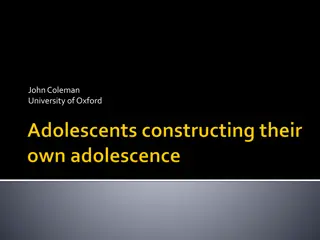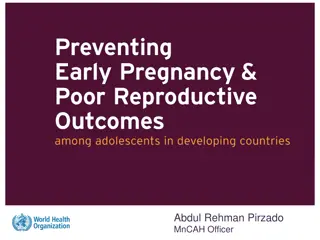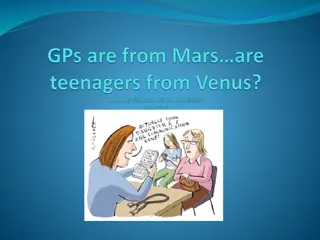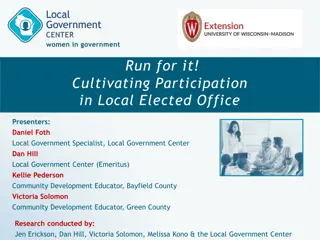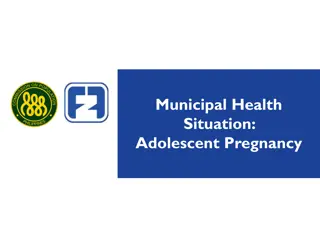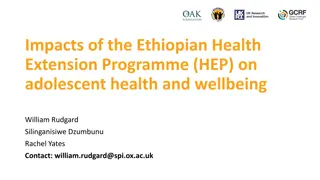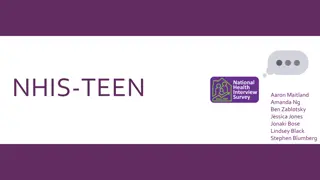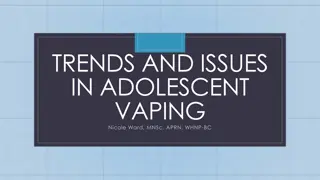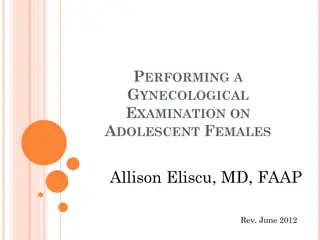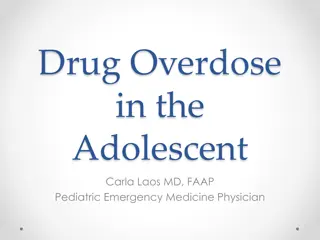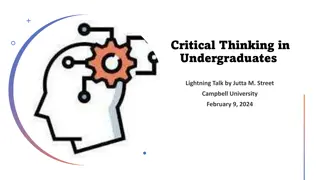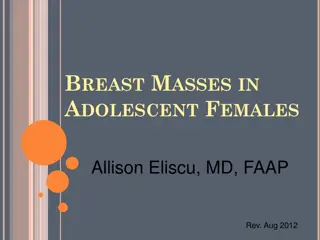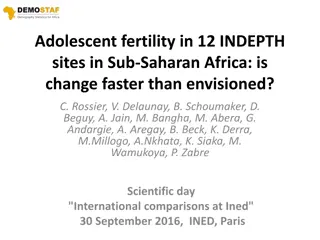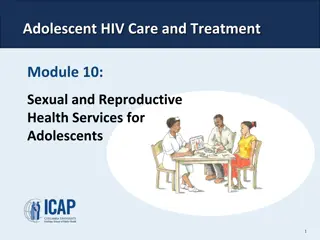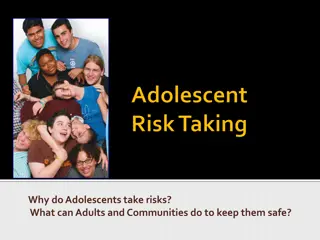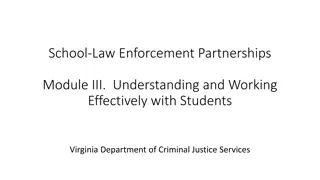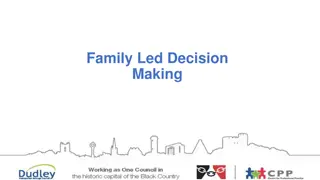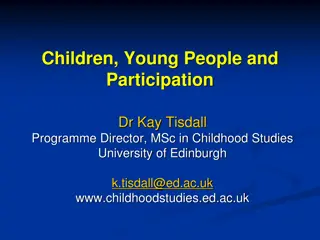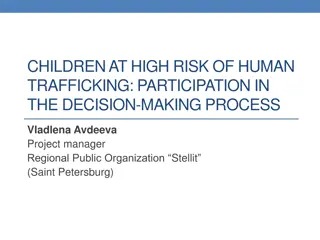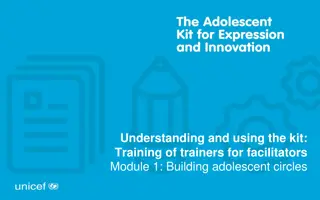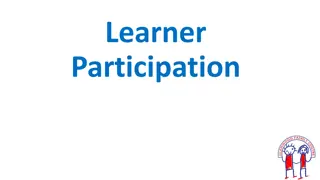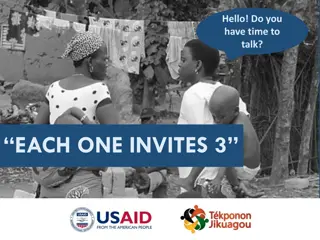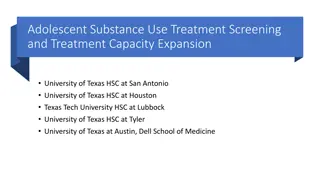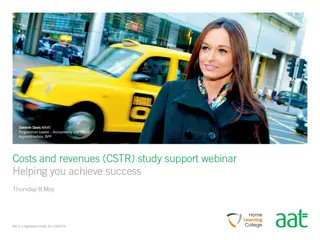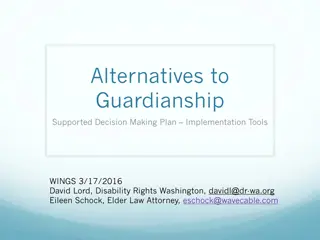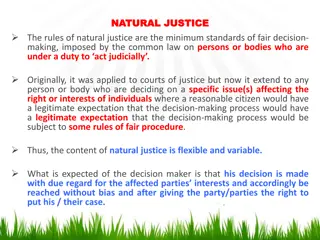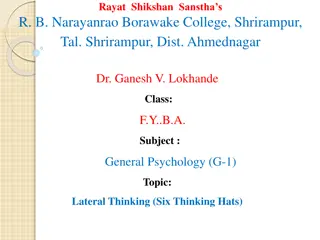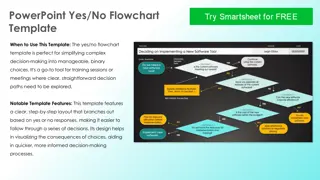Encouraging Family Participation in Adolescent Decision Making
This presentation supported by the Office of Population Affairs aims to inform participants about compliance expectations with Title X requirements related to family planning services. It emphasizes the importance of family involvement in adolescent decision-making in seeking such services, offering recommendations for quality family planning services alignment with the QFP. The target audience includes staff providing family planning services, focusing on promoting communication strategies between adolescents and parents or guardians.
- Family Participation
- Adolescent Decision Making
- Family Planning Services
- Compliance Expectations
- Quality Recommendations
Uploaded on Oct 01, 2024 | 0 Views
Download Presentation

Please find below an Image/Link to download the presentation.
The content on the website is provided AS IS for your information and personal use only. It may not be sold, licensed, or shared on other websites without obtaining consent from the author. Download presentation by click this link. If you encounter any issues during the download, it is possible that the publisher has removed the file from their server.
E N D
Presentation Transcript
Encouraging Family Participation in Adolescent Decision Making September 2016 Family Plan n in g N atio nal Training Centers Suppo r ted by O ffice o f Po pulatio n Affairs
Acknowledgement This presentation is supported with grant funds from the Office of Population Affairs of the U.S. Department of Health and Human Services. The information presented does not necessarily represent the views of OPA, HHS, or FPNTC member organizations. Family Plan n in g N atio nal Training Centers Suppo r ted by O ffice o f Po pulatio n Affairs
The Purpose The purpose of this presentation is that participants will be better informed of expected compliance with the requirement that is part of Title X statutory language as well as the legislative mandate regarding seeking family planning services that encourages family participation in adolescent decision making. Family Plan n in g N atio nal Training Centers Suppo r ted by O ffice o f Po pulatio n Affairs
Quality Family Planning Services Recommendations Also known as the QFP Clinic administrators and clinic staff should align their policies, procedures and practices with the QFP in providing quality family planning services to ensure the encouragement of family participation in the decision of minors to seek family planning services Gavin, L., Moskosky, S., Carter, M., et al. Providing Quality Family Planning Services: Recommendations of CDC and the U. S. Office of Population Affairs. MMWR Recomm Rep. 2014; 63: 1-54 Family Plan n in g N atio nal Training Centers Suppo r ted by O ffice o f Po pulatio n Affairs
Target Audience This presentation is intended for administrative, clinical and all other staff that provide family planning services. Family Plan n in g N atio nal Training Centers Suppo r ted by O ffice o f Po pulatio n Affairs
Objectives 1. Discuss the Title X requirement to provide counseling that encourages family participation in the decision of minors to seek family planning services. 2. Describe available professional resources on how to promote communication strategies between an adolescent and parent or guardian. Family Plan n in g N atio nal Training Centers Suppo r ted by O ffice o f Po pulatio n Affairs
Overview Why family participation is important Research Title X Statute Legislative Mandate Communication Youth friendly services Strategies Resources References Family Plan n in g N atio nal Training Centers Suppo r ted by O ffice o f Po pulatio n Affairs
Why Family Participation Is Important Sexual development is a normal part of the teen years. Parents have a strong impact on whether a teenager makes healthy decisions for himself or herself. www.cdc.gov.Parent and Guardian Resources 2014 To prevent unintended pregnancy, providers should give comprehensive information to adolescents about how to prevent pregnancy. 75% of pregnancies among 15-19 year olds were unintended. In a given year, approximately 20% of adolescent births represent repeat births. Gavin, et al. QFP. MMWR 2014 N.Engl J Med 2016 Hamilton B. Births: 2010 Family Plan n in g N atio nal Training Centers Suppo r ted by O ffice o f Po pulatio n Affairs
Research Research shows that adolescents who talk with parents about topics related to dating, healthy relationships, and pregnancy and STD prevention are more likely to: Begin to have sex at a later age. Use condoms or other birth control more often if they do have sex. Have better communication with romantic partners. Have sex less often Health providers and educators should encourage and promote communication between an adolescent and his or her parent(s) or guardians(s). Family Plan n in g N atio nal Training Centers Suppo r ted by O ffice o f Po pulatio n Affairs
Title X Statute Sec. 1001 The Secretary is authorized to make grants to and enter into contracts with public or nonprofit private entities to assist in the establishment and operation of voluntary family planning projects which shall offer a broad range of acceptable and effective family planning methods and services (including natural family planning methods, infertility services, and services for adolescents). To the extent practicable, entities which receive grants or contracts under this subsection shall encourage family participation in projects assisted under this subsection. Family Plan n in g N atio nal Training Centers Suppo r ted by O ffice o f Po pulatio n Affairs
Legislative Mandate None of the funds appropriated in this Act may be made available to any entity under Title X of the Public Health Service Act unless the applicant for the award certifies to the Secretary of Health and Human Services that it encourages family participation in the decision of minors to seek family planning services and that it provides counseling to minors on how to resist attempts to coerce minors into engaging in sexual activities. Title X Program Requirements, Section 9.12 Family Plan n in g N atio nal Training Centers Suppo r ted by O ffice o f Po pulatio n Affairs
Legislative Mandate, continued None of the funds appropriated in this Act may be made available to any entity under Title X of the Public Health Service Act unless the applicant for the award certifies to the Secretary of Health and Human Services that it encourages family participation in the decision of minors to seek family planning services and that it provides counseling to minors on how to resist attempts to coerce minors into engaging in sexual activities. Title X Program Requirements, Section 9.12 Family Plan n in g N atio nal Training Centers Suppo r ted by O ffice o f Po pulatio n Affairs
Communication Clinic Staff Role Adolescents who come to the service site alone should be encouraged to talk to their parents or guardians. Providers should encourage and promote communication between the adolescent and his or her parent(s) or guardian(s) about sexual and reproductive health. When both parent or guardian and the teen have agreed, joint discussions can address family values and expectations about dating, relationships, and sexual behavior. Gavin, et al. QFP. MMWR 2014 Family Plan n in g N atio nal Training Centers Suppo r ted by O ffice o f Po pulatio n Affairs
Quality Counseling Quality Family Planning Services Recommendations (the QFP ) Gavin, L., Moskosky, S., Carter, M., et al. Providing Quality Family Planning Services: Recommendations of CDC and the U. S. Office of Population Affairs. MMWR Recomm Rep. 2014; 63: 1-54; Appendix C. Family Plan n in g N atio nal Training Centers Suppo r ted by O ffice o f Po pulatio n Affairs
Communication Educational Materials Educational materials and programs can be provided to parents or guardians that help them talk about sex and share their values with their child . The CDC and the Office of Adolescent Health (OAH) provide excellent and up-to- date educational materials for professionals to help talk with teens and parents. These materials are easily available online for parents or guardians to access on their own. Gavin, et al. QFP. MMWR 2014 Family Plan n in g N atio nal Training Centers Suppo r ted by O ffice o f Po pulatio n Affairs
Teen Friendly Services Services for adolescents should be provided in a youth friendly manner, which means that they are accessible, equitable, acceptable, appropriate, comprehensive, effective, and efficient for youth Gavin, et al. QFP. MMWR 2014 www.cdc.gov Family Plan n in g N atio nal Training Centers Suppo r ted by O ffice o f Po pulatio n Affairs
Confidentiality Confidentiality is critical for teens and can greatly influence their willingness to access and use services. As a result, many professional medical associations have emphasized the importance of providing confidential services to adolescents. Gavin, et al. QFP. MMWR 2014 ACOG, May 2014 Family Plan n in g N atio nal Training Centers Suppo r ted by O ffice o f Po pulatio n Affairs
Explaining Confidentiality Explain to the adolescent that all information is confidential, meaning kept private, unless a person discloses possible harm to themselves or others. In that case you would have to report it to the appropriate authorities. You must know your State laws and the required reporting process for your agency and your role. Refer to the training resources www.fpntc.org Family Plan n in g N atio nal Training Centers Suppo r ted by O ffice o f Po pulatio n Affairs
Legislative Mandate Notwithstanding any other provisions of law, no provider of services under Title X of the Public Health Services Act Shall be exempt from any State law requiring notification or the reporting of child abuse, child molestation, sexual abuse, rape, or incest. Title X Program Requirements, Section 9.12 Family Plan n in g N atio nal Training Centers Suppo r ted by O ffice o f Po pulatio n Affairs
Mandatory Reporting Providers of family planning services should offer confidential services to adolescents and also observe all relevant state laws and any legal obligations. Each state has mandatory laws or legal notification requirements such as reporting of child abuse, child molestation, sexual abuse, rape, or incest, as well as human trafficking. Gavin, et al. QFP. MMWR 2014 Family Plan n in g N atio nal Training Centers Suppo r ted by O ffice o f Po pulatio n Affairs
Mandatory Reporting Policies and Training Guide The Mandated Child Abuse Reporting Law: Developing and Implementing Policies and Training guide was developed to assist you in developing or revising your clinic reporting policies and staff training procedures. Specific guidance on individual state law are not covered because state laws vary across the country. Who Should Use this Guide This document is for those persons in charge of developing and updating child abuse reporting policy, training and resources for clinicians at Title X service sites. Visit www.fpntc.org Family Plan n in g N atio nal Training Centers Suppo r ted by O ffice o f Po pulatio n Affairs
Strategies! To explore various strategies and approaches for: Adolescents Parents Healthcare Providers Communities www.hhs.gov/ash/oah/adolescent-health-topics/ Family Plan n in g N atio nal Training Centers Suppo r ted by O ffice o f Po pulatio n Affairs
Questions? Family Plan n in g N atio nal Training Centers Suppo r ted by O ffice o f Po pulatio n Affairs
Staff Training Program Requirements for Title X Funded Family Planning Projects April 2014 Section 8.6 Staff Training and Project Technical Assistance Routine training should be provided on: Federal and State requirements for reporting or notification of child abuse, child molestation, sexual abuse, rape or incest, and human trafficking Involving family members in the decision of minors to seek family planning services Counseling minors on how to resist being coerced into sexual activities Visit www.fpntc.org for trainings on above topics Family Plan n in g N atio nal Training Centers Suppo r ted by O ffice o f Po pulatio n Affairs
Resources for Professionals and Parents Centers for Disease Control and Prevention Parent and Guardian Resources http://www.cdc.gov/teenpregnancy/parent-guardian-resources/index.htm Centers for Disease Control and Prevention Teen friendly clinic environment http://www.cdc.gov/teenpregnancy/health-care-providers/teen-friendly-health- visit.htm The Office of Adolescent Health, U.S. Department of Health and Human Services Tips to help parents talk to adolescents http://www.hhs.gov/ash/oah/resources-and-publications/info/parents The Office of Adolescent Health, U.S. Department of Health and Human Services Talking with Teens Conversation Tools http://www.hhs.gov/ash/oah/resources-and-publications/info/parents/conversation- tools/# Family Plan n in g N atio nal Training Centers Suppo r ted by O ffice o f Po pulatio n Affairs
Resources, continued The Office of Adolescent Health, U.S. Department of Health and Human Services. Strategies & Approaches (Updated May 13, 2016) http://www.hhs.gov/ash/oah/adolescent-health-topics/reproductive-health/teen- pregnancy/tips-for-parents.html ACOG, Committee Opinion, Number 598, May 2014, Committee on Adolescent Health Care http://www.acog.org/Resources-And-Publications/Committee-Opinions/Committee-on- Adolescent-Health-Care/The-Initial-Reproductive-Health-Visit Family Plan n in g N atio nal Training Centers Suppo r ted by O ffice o f Po pulatio n Affairs
References Gavin, L., Moskosky, S., Carter, M., et al. Providing Quality Family Planning Services: Recommendations of CDC and the U. S. Office of Population Affairs. MMWR Recomm Rep. 2014; 63: 1-54 American Academy of Pediatrics. Parents matter: your children want to learn about the facts of life from you. Elk Grove Village, IL: American Academy of Pediatrics; ND. Anderson NLR, Koniak- Griffin D, Keenan CK, Uman G, Duggal BR, Casey C. Evaluating the outcomes of parent- child family life education. Sch Inq Nurs Pract 1 999;1 3:21 1 38. Blake SM, Simkin L, Ledsky R, Perkins C, Calabrese JM. Effects of a parent- child communications intervention on young adolescents' risk for early onset of sexual intercourse. Fam Plann Perspect 2001 ;33:52 61 . Family Plan n in g N atio nal Training Centers Suppo r ted by O ffice o f Po pulatio n Affairs
References, continued Finer LB, Zolna, MR. Declines in Unintended Pregnancy in the United States, 2008-2011. N Engl J Med 2016; 374:843-52. Ford CA, Davenport AF, Meier A, McRee AL. Partnerships between parents and health care professionals to improve adolescent health. J Adolesc Health. 2011 Jul;49(1):53-7. Guilamo- Ramos V, Bouris A, Jaccard J, Gonzalez B, McCoy W, Aranda D. A parent- based intervention to reduce sexual risk behavior in early adolescence: building alliances between physicians, social workers, and parents. J Adolesc Health 201 1 ;48:1 59 63. Huston RL, Martin LJ, Foulds DM. Effect of a program to facilitate parent- child communication about sex. Clin Pediatr (Phila) 1 990; 29:626 33. Family Plan n in g N atio nal Training Centers Suppo r ted by O ffice o f Po pulatio n Affairs
References, continued Kirby DB, Laris BA, Rolleri LA. Sex and HIV education programs: their impact on sexual behaviors of young people throughout the world. J Adolesc Health 2007; 40:206-17. Lederman RP, Chan W, Roberts- Gray C. Sexual risk attitudes and intentions of youth aged 1 2 1 4 y ears: survey comparisons of parent- teen prevention and control groups. Behavioral Medicine (Washington, DC) 2004; 29:1 55 63. Murry VM, Berkel C, Brody GH, Gerrard M, Gibbons FX. The Strong African American Families program: longitudinal pathways to sexual risk reduction. J Adolesc Health 2007;41 :333 42. Stanton B, Cole M, Galbraith J, et al. Randomized trial of a parent intervention: parents can make a difference in long- term adolescent risk behaviors, perceptions, and knowledge. Arch Pediatr Adolesc Med 2004;1 58:947 55. Family Plan n in g N atio nal Training Centers Suppo r ted by O ffice o f Po pulatio n Affairs
Contact Us Follow us on Twitter @fp_ntc Subscribe to our newsletters at fpntc.org/enewsletter Questions ? Contact www.fpntc.org Family Plan n in g N atio nal Training Centers Suppo r ted by O ffice o f Po pulatio n Affairs



